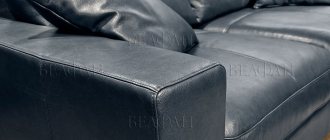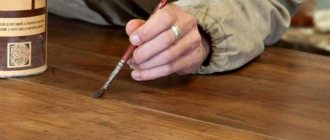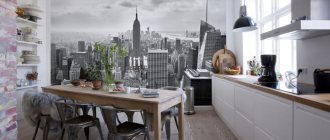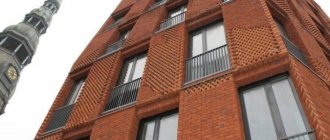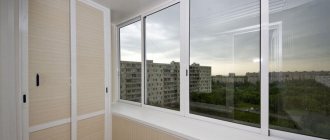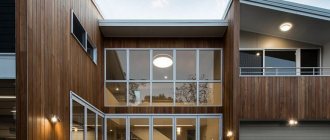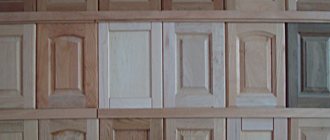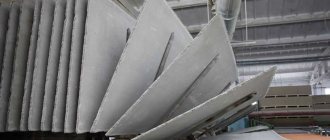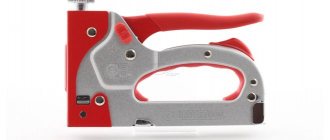62465
Beautiful, functional furniture is a must-have attribute of a home, office or apartment. Cabinet products in furniture production are decorated with facades treated with film material. A coating such as PVC film for furniture facades protects elements from moisture, scratches, damage and has an important decorative function. The coating allows you to implement many interesting ideas and design projects.
Kitchen PVC facades - advantages and disadvantages
The kitchen facade in PVC film is a plate covered with a thin layer of polyvinyl chloride.
The advantages of film facades include:
- resistance to deformation and wear resistance;
- PVC is not afraid of moisture and moderate temperature influences;
- a wide selection of shades, coating textures and the ability to purchase a façade of any shape (curved, figured);
- lack of sensitivity to UV rays, due to which the panels do not fade or lose color;
- affordable price compared to veneered, wooden and plastic products.
Film kitchen facades also have disadvantages that you need to know about before purchasing. The first, and most unpleasant one, is that the PVC coating may peel off, especially if the cabinet is located above the hob. In addition, the film is susceptible to mechanical damage and can deteriorate when using cleaning agents with abrasive particles, and is also not subject to restoration (except for cases where it comes off).
Protective film - Silicone tablecloth
ideal protection for your furniture
- Ideal protection against scratches, dirt, chips!
- Eco-friendly, non-toxic and odorless
- Completely transparent
- The service life of the tablecloth is 10 years.
- Withstands temperatures up to +80
We will produce a protective film according to your dimensions in 1 day, pack it securely, include instructions and deliver the protective film anywhere in the Russian Federation in 3 days, and you can pay (purchase) upon receipt. Free shipping
To learn more
Base for PVC film coating - materials and requirements
The PVC-coated panel consists of three parts:
- basics;
- films;
- edge finishing (sides).
Not every base is suitable for covering with film. Manufacturers use two options - chipboard and MDF.
Chipboard facades will be cheaper, but their durability is a very controversial issue. This material absorbs moisture well and swells, causing the film to begin to peel off. In addition, the toxic resins that make up chipboard can evaporate into the air when the integrity of the coating is damaged and have a toxic effect on the human body and domestic animals.
It is thanks to cheap chipboard structures that film coating has an undeserved reputation as a low-quality and unreliable material.
Theoretically, PVC can also be coated on panels made of well-sanded natural wood. But, as a rule, the manufacturer does not strive to hide, but rather to emphasize the appearance and natural pattern, so wood is also not suitable for applying film.
PVC coating is best used for facades made of MDF - an environmentally friendly and safe material with high performance characteristics. It does not deform, is resistant to moisture and high temperatures, and its smooth, jagged surface reduces the risk of film peeling.
Methods of application
Polymer materials are a very popular finishing option; they provide neat facade decor and protection from many external factors. According to the method of application, PVC coatings are divided into the following types:
- Membrane-vacuum. The equipment used is a vacuum press, most often used for countertops, doors between rooms, cabinets, chests of drawers, bookshelves. Thickness - from a quarter to half a millimeter.
- Laminating. The process of gluing or pressing together two surfaces is called laminating. It is carried out using special equipment. It is used for various surfaces made of fiberboard and MDF, including window sills. The thickness of the cladding usually does not exceed three tenths of a millimeter.
- For lamination. Cladding is done on a machine because work is usually carried out on fairly long elements made of metal, plastic or wood in order to protect them from water and give them strength. Two-layer PVC film provides more complete protection from influences, including sun rays.
- Transparent. This type of material is very thin, almost like food grade, it does not perform its functions for too long, but it stretches well, and it is convenient to completely cover the product. Usually it is chosen for transporting something, securing it to the surface of the cargo with glue that does not leave any traces behind.
- For chipboard and MDF. Intended for individual parts, for example, ends. A special machine is used to stretch it, so it is difficult for a beginner to achieve good quality at home, although some craftsmen try to do this, using, for example, a hair dryer.
Functionality of furniture aluminum profiles, subtleties of choice
Film can be applied to surfaces in different ways:
- Laminating. This process has several subspecies, differing in temperature. Smooth elements are processed using the cold method, glue is applied to them, and then the coating is rolled under pressure. During warm processing, the glue is preheated to melt off excess water. The hot type of finishing is carried out at a temperature of 120-160 degrees, using heated rolling rollers.
- Lamination. In this case, no glue is used; the fastening effect is exerted by heat and pressure, which make the substance plastic. The result is a solid, non-delaminating fabric. Waste material is subject to recycling and reuse.
- Post-formation. The most effective option. The layered coating is applied to a base coated with glue on a positioning machine. The press used has a relief that gives the finished product an interesting texture.
Glossy PVC film is usually applied using a vacuum method.
Every technology has its limitations. For example, when laminating, it is imperative that the object be smooth, without protruding fragments or nicks. During post-formation, it must withstand the load that the equipment will place on it.
Purpose of furniture supports, overview of the main varieties
In general, polyvinyl chloride film for furniture facades is easy to use and has many advantages. It not only gives the furniture a glossy and presentable appearance, but also saves it from accidental damage and premature aging, chemical, thermal and other influences.
For chipboard and MDF
Membrane-vacuum
Transparent
Types of PVC films for kitchen facades
To cover the facades, PVC film with a thickness of 0.05 to 0.8 mm is used. Depending on the application method and performance properties, the following types of material are distinguished:
- membrane-vacuum film (0.25-0.5 mm) - intended for vacuum pressing of bent facades;
- PVC for laminating (up to 0.3 mm) - used for laminating smooth panels;
- PVC for lamination (0.3-0.5 mm) - allows you to laminate surfaces not only in one, but also in several layers.
For home use, self-adhesive film in rolls (0.3-0.5 mm) is used.
PVC coating is applied in one of three ways:
- laminating;
- lamination;
- post-formation.
Laminating is based on preliminary application of glue to the base and pressing the film against it under conditions of high pressure and temperature. The cost of lamination for the manufacturer is much more economical, but the quality of gluing leaves much to be desired - PVC can quickly peel off.
Lamination is the cladding of a façade at critical temperatures. After applying the film, the facade is additionally covered with a protective layer. This method is much more reliable than laminating.
Postforming is the most advanced technology for applying PVC. The film is applied to the surface in an even layer and then placed under a special press. If it is necessary to give the cladding a certain pattern or shape, then it is also adjusted under the press.
<
>
Self-adhesive film can be used to cover furniture at home. First, you need to thoroughly clean the surface of the facade from dust and wipe it with a degreaser (for example, white spirit), and then carefully apply the PVC coating. To get rid of bubbles, the coating can be smoothed with a spatula wrapped in cloth. Unfortunately, such film will not last long.
When choosing a film, pay attention to the country of origin. It is believed that products from European manufacturers are more reliable, PVC from Italy is especially valued. However, factory-made Chinese and Korean film is no worse, but costs less.
Pasting furniture facades at home
And now we propose to consider how to glue MFD film to a facade that has a flat surface.
To complete all the work that is planned, you will need the following tools and devices:
- White spirit.
- PVC film.
- Lint-free soft cloth.
- Wide and new spatula for plastering.
- Sharp scissors.
- Stationery knife (very sharp).
- Household hair dryer.
Please note that you should really only use a new spatula, since a used tool will still have irregularities that are almost invisible, and they will scratch the films during smoothing.
The upcoming work consists of the following stages:
Gluing PVC film to the furniture facade => preparing the surface for processing => cutting PVC film => gluing the material to the furniture => trimming excess film => final leveling of the finished surface.
Instructions for gluing the PVC coating yourself are attached below. Despite the fact that the described steps for gluing film on MDF are simple in themselves, the quality of the final result will largely depend on how accurately you follow it.
Instructions:
- First, you should thoroughly wipe the surface to be decorated using a rag soaked in white alcohol.
- Afterwards, in order to perfectly glue the MDF film to the furniture facade, measure the perimeter of the surface to be pasted and, according to the measurement data, cut the self-adhesive film with a margin of a couple of centimeters on all sides.
- Roll the self-adhesive material into a roll with the wrong side up.
- Place the edge of the film against the edge of the facade and separate the edges of the backing.
- Next, you should gradually unroll the roll and separate the backing layer.
- Use a spatula wrapped in fabric to smooth out the self-adhesive material so that there are no air bubbles underneath it.
- After the film is evenly glued over the entire surface, the excess film should be trimmed around the entire perimeter.
- Next, warm up the perimeter of the facade with a household hairdryer and additionally iron everything again with a spatula wrapped in fabric.
- Use a similar method if there are bubbles on the product.
If you follow all the instructions correctly, the result will be almost the same as on factory-made furniture facades.
Please note that a feature of adhesive-based PVC films is the small thickness of the material. As a result, even small specks of dust or irregularities on the surface being pasted will be visible to the naked eye. For this reason, you should wipe the facade with a damp cloth and check for dust under a bright flashlight or lamp before starting work.
Pasting tabletops with wood-look film
You are already familiar with how to cover furniture facades, and now let's look at how to finish a kitchen countertop. The main stages of the completed work will differ little from the previous method, so it’s better to just post a photo with explanations.
So, to begin with, the tabletop should be sanded using an angle grinder, and the grain size should be changed from medium to fine. The need for sanding is due to the fact that the tabletop will have a lot of chips and scratches on both the front side and the ends. Round depressions and scratches should be treated with a putty solution, and then the workpiece should be finally sanded and wiped with a lint-free cloth soaked in white alcohol.
After this, the tabletop should be laid in a horizontal position. We cut the pre-prepared film so that there is enough of it for the ends, and not just for the front surface. Apply the film, while gradually removing the backing and dispersing unevenness along the edges. When the main surface is pasted over, bend it at the ends. You should make cuts in the corners using a stationery knife and fit the bottom piece of film under the top one. Align the film along the end with a rag.
The remaining folds should be heated with a hairdryer and, once warm, smoothed out with a rag. After complete cooling, the film will stretch itself and the ends will be perfectly even.
Interestingly, the technology described above can be used not only for pasting furniture facades and table tops, but also for decorating furniture, large household appliances and other things.
Basic data about the film facade
Finally, I would like to shed more light on the topic of film facades, as well as what their advantages and disadvantages are. Film facades are a popular solution for making furniture mainly for bathrooms and kitchens. The scope of application of furniture made from such material is not accidental, since MDF boards coated with PVC film are resistant to high levels of humidity. That is, if there is no hood installed in the kitchen, and there is no effective ventilation system in the bathroom, then such furniture purchased by you will serve faithfully for many years.
Can you say the same about furniture that you covered yourself with self-adhesive vinyl? Unfortunately, no, since do-it-yourself tiled facades are not as reliable as factory-made analogues. Self-adhesive film, no matter how well it is glued, does not guarantee the tightness of the coating. Factory-made facades do not have open gluing areas, and for this reason, humid air will not have any effect on the MDF.
If we compare which is better - film, plastic or enamel for finishing MDF boards, it is worth noting that all coatings have their drawbacks, which should be taken into account when choosing pieces of furniture. But keep in mind that there is one drawback of film facades - the impossibility of restoring film that is damaged. However, the cost of the façade is reasonable and, if necessary, it will always be possible to update them entirely.
Decorative qualities of PVC film facades for kitchen units
Kitchen PVC facades can have a variety of colors and textures. Film manufacturers take into account fashion trends: as soon as a certain material becomes popular, they produce a PVC coating that imitates its shade and texture. Thanks to this technique, you can purchase facades “metal-like,” “wood-like,” or “glass-like.”
The film can be:
- glossy;
- matte;
- mirror
Thanks to modern technologies, various images and patterns can be applied to PVC coatings. 3D drawings that imitate three-dimensional details - stucco molding, milling or decorative carvings - have become widely popular.
Rules for care and operation - how to extend the service life of a kitchen facade with PVC film coating
The quality of care for PVC facades has a serious impact on their durability and appearance.
To make your furniture pleasing to the eye longer, follow these recommendations:
- do not use abrasive and chemically aggressive chlorine-based detergents to clean the panels;
- protect facades from mechanical damage - scratches and impacts;
- do not expose surfaces to temperatures above 70. If a cabinet with a PVC facade is located above the hob, it is advisable to use a powerful hood;
- Film overcooling is not allowed - up to - 15.
But what to do if the PVC film peels off? In this case, you must first check whether the warranty period for the furniture has expired. If not, the manufacturer will restore the furniture himself, but only if you followed the recommendations for caring for the furniture.
If the warranty period has expired or the coating has peeled off due to careless handling of the facades, you can restore the film yourself.
To do this you will need glue or liquid nails. You can also use PVA; PVA Moment Joiner is especially suitable. It needs to be drawn into a medical syringe (you can use a special glue gun) and carefully inserted under the peeled off section of the film. Then press firmly and remove the remaining substance with a cloth.
Photos of kitchens with PVC film facades
<
>
Thus, PVC-coated facades are an inexpensive, stylish and practical option for decorating kitchen furniture. A wide selection of shades and textures will help you decorate your kitchen in any style. And if the operating rules are followed, panels covered with film will last a very long time.

